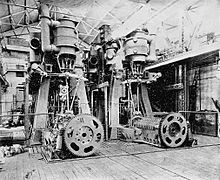SS St. Louis (1894)
 St. Louis seen off New York in 1900.
| |
| History | |
|---|---|
| Name | St. Louis |
| Owner | International Navigation Company |
| Operator | American Line |
| Route | |
| Builder | William Cramp & Sons, Philadelphia |
| Yard number | 277 |
| Launched | 12 November 1894 |
| In service | 1895 |
| Out of service | 1918 |
| Homeport | New York City |
| Fate |
|
| Name | USS St. Louis |
| Commissioned | 24 April 1898 |
| Decommissioned | 2 September 1898 |
| Fate | Returned to owners, 1898 |
| Name | USS Louisville |
| Acquired | 17 April 1918 |
| Commissioned | 24 April 1918 |
| Decommissioned | 9 September 1919 |
| Fate | Returned to owners, 1919. Scrapped 1924 |
| General characteristics | |
| Type | Auxiliary cruiser / Troopship |
| Displacement | 14,910 long tons (15,149 t) |
| Length | 554 ft (169 m) |
| Beam | 63 ft (19 m) |
| Draft | 30 ft (9.1 m) |
| Speed | 20 knots (37 km/h; 23 mph) |
| Complement | 377 |
| Armament |
|
| Service record | |
| Operations: | |
SS St. Louis was a passenger liner built in 1894 and sponsored by the wife of U.S. President
Service history

Spanish–American War
On a later voyage following the outbreak of the Spanish–American War, St. Louis was chartered for Naval service while at Southampton and returned to New York on 22 April 1898. Armed with four 5-inch rapid fire guns and eight 6-pounders, she was commissioned as an auxiliary cruiser in the United States Navy on 24 April, Capt. Caspar F. Goodrich in command. St. Louis, crewed by 27 officers and 350 men, departed on 30 April for the Caribbean.
St. Louis was specially outfitted with heavy drag lines in order to destroy undersea cable communications in the
St. Louis next severed the cable between
St. Louis received many prisoners of war, including Admiral Cervera, for internment in the United States and landed them at Portsmouth, N.H., on 11 July. She steamed south from Norfolk on the 28th to cruise among ports of Puerto Rico and Cuba until 10 August; then sailed for New York where she arrived on the 14th. She shifted to Philadelphia on 24 August to enter the Cramp shipyard for preparation for return to her owners. St. Louis was decommissioned on 2 September and was turned over to Mr. J. Parker, a representative of the American Lines.
World War I
For many years, SS St. Louis was prominent as a passenger liner between New York and Liverpool. For example, in June 1906, the newly married Alice Roosevelt Longworth sailed on the ship for her first trip to Europe.[1] On 17 March 1917, she was provided with an armed guard of 26 sailors and equipped with three 6-inch guns to defend against enemy attack on her New York-to-Liverpool service route. On 30 May, while proceeding up the Irish Sea and skirting the coast of England, she responded rapidly to the orders, "Hard Starboard," at the sighting of a periscope, and succeeded in dodging a torpedo while apparently striking the submarine which fired it. Later dry-dock examination revealed that 18 feet of her keel rubbing strake had been torn away. On 25 July, her gunners exchanged fire with a surfaced U-boat, some three miles away, and sighted many near misses.

On 17 April 1918, St. Louis was delivered to the Navy at New York to be wholly manned and operated by the Navy as a troop transport. She was renamed Louisville (SP-1644) to avoid confusion with the heavy cruiser St. Louis. Louisville was commissioned on 24 April.
Louisville first put to sea on 12 October bound for Portland and Southampton, England, and returned to New York on 7 January 1919. From then until 19 August of that year, she made six voyages from New York to Liverpool or to Brest, France, to return American soldiers from the Great War. On 20 August, she shifted to Norfolk and was decommissioned there on 9 September 1919. She was returned to her owner on the 11th and resumed her original name, St. Louis.
Destruction
On 8 January 1920, while St. Louis was being reconditioned as a passenger liner in Hoboken, N.J., a workman's blowtorch ignited a fire. The fire raged into the next day, 9 January. When the fire could not be controlled, the ship was scuttled at the dock and allowed to burn. The only thing left after the fire was her steel hull. Damages were estimated at $1 million.[2] She was later refloated and taken over by insurance underwriters. Over the next five years, under ownership of various investors, she lay at docks in different parts of New York Harbor. Finally, she was sold in 1925; and two Dutch tugs towed her to Italy where she was scrapped by an Italian salvage company.
Notes
- ^ Louisville was chosen as a name so as not to confuse this ship with the cruiser USS St. Louis (C-20).
References
- This article incorporates text from the public domain Dictionary of American Naval Fighting Ships. The entry can be found here.
External links
- "The New American Atlantic Liner St. Louis", Scientific American, 11 August 1894
- A detailed report on the ship and experiences of an agent from a rival company (1902)
- ISBN 978-0-405-12846-2.
- ^ United Press, “Fire Damage To Liner Is Put At $1,000,000,” Riverside Daily Press, Riverside, California, Saturday 10 January 1920, Volume XXXV, Number 9, page 1.
